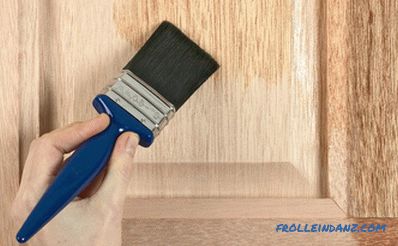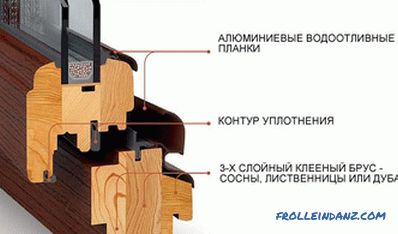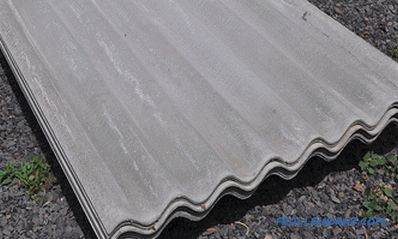Sealing in rooms with high humidity and constant temperature changes should be necessary. Silicone is considered the most popular because it has a large number of advantages. In the process, small parts of the composition can get on your hands, clothes or processed material. In this article we will explain how to remove silicone sealant from acrylic bath, tile, as well as clothing.
General information
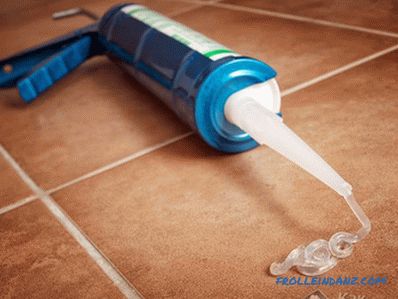 This may look like a silicone sealant
This may look like a silicone sealant
Silicone sealant is widely used when working with various items and materials. In particular, they can carry out sealing plumbing, window frames, glass, mirrors and other types of finishes. Due to the presence of a number of properties, it can be called a universal remedy. It is necessary to highlight the most important characteristics:
- elasticity;
- reasonable price;
- ease of operation;
- moisture resistance;
- heat resistance;
- long life.
Before you go shopping for a store, you need to familiarize yourself with the other side of the process: how to remove residual sealant after work.
Manufacturers and professional craftsmen recommend selecting a method for removing sealant depending on its composition. To date, there are several main types of sealants: sanitary, aquarium, automotive, universal and others.
Mechanical method

The most effective and simple solution is mechanical removal or force method. The main purpose of this method is to damage the structure of the sealant. But if we are talking about removing residues from a tile, glass or mirror, this is a bad idea. The process uses pumice stone and a knife, so the finish can be scratched or damaged by its appearance. It is most expedient to resort to the mechanical method when:
- there is no risk of scratching the surface;
- it is possible to restore the integrity of the layer without difficulties;
- the sealant is removed in the zone , which will be hidden from prying eyes (behind the bathroom, appliances or furniture);
- the use of chemicals will cause great damage;
- the appearance does not play a role (basement room).
Initially, you need to remove large pieces of silicone, and then move on to medium and small ones. After such actions, spots are formed. In most cases, you can get rid of them with simple dishwashing detergents and foam cleaners. If the procedure did not produce the desired result, it is worth exploring other methods.
The main tool for mechanical cleaning is the knife. To minimize deformation, choose a thin blade with a sharp end.
Combined method
This method involves the use of both the method described above and the chemicals. Consider in more detail than to clean the surface of the silicone sealant.
White spirit
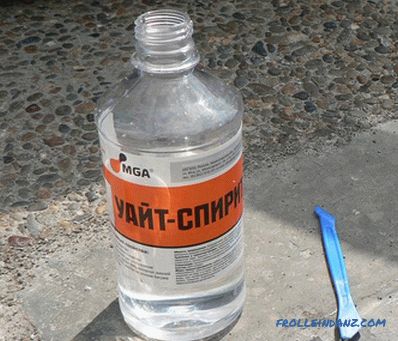
A rag or sponge is moistened with a solvent, which is treated with a small area - the white spirit evaporates quite quickly. After only 30 seconds, the sealant seam should be soft and pliable, which will allow you to gently remove it with a knife or spatula. If the layer is too thick, repeat the process until it is completely clean. Wash off the stains can be a solvent, and then wipe dry with a soft lint-free cloth or paper towel.
Acetone
Removal technology is the same as in the above case. It is important to remember that in its composition acetone is quite aggressive. Therefore, before using it, it is necessary to verify compatibility with the base material. For example, they can not clean the plastic, as the solvent will corrode PVC. In addition, acetone easily penetrates the human body through the skin.
When using solvents, care must be taken to protect respiratory organs and skin. Use respirators and rubber gloves.
Salt
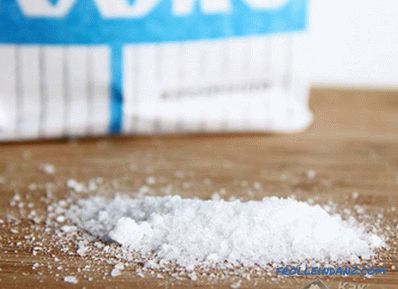
An additional method to remove a small layer or stain from the bath is to use salt. The technology is quite simple: a tampon is made from a bandage or gauze, into which a small amount of salt is placed. Swab moistened in warm water and wipe the desired area.
High temperature
In order for the efficiency of the above-described processes to be several times higher, it is recommended, if possible, to pre-heat the surface. After the material is fully heated, even household chemicals can be used.
Specialized chemical solutions
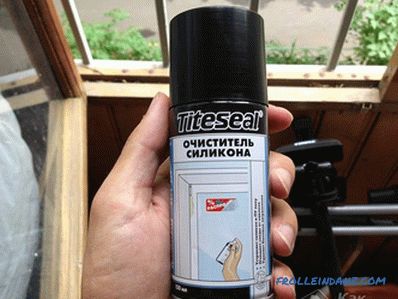 Silicone cleaner
Silicone cleaner
If there is no desire and time to remove old sealant from the surfaces by the indicated methods, other options can be considered - special chemical solvents. They are sold in the same stores, where the sealants themselves.In addition, manufacturers have taken care to simplify the selection of the desired type, and indicated on the label for which sealant you can use a solvent. They also differ in their consistency:
- pastes;
- foams;
- aerosols;
- solutions.
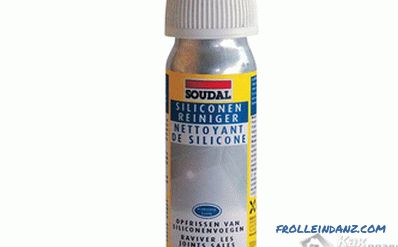 Sealant removal agent
Sealant removal agent
The instructions for use are shown on each label. But in general, all actions can be described by the standard algorithm:
- Before use, the surface is well cleaned and the product is tested on an inconspicuous area. This will let you know if the chemical is corrosive paint or enamel finishing material.
- During work, gloves and respirators should be used, since chemical solutions emit harmful vapors into the air.
- After softening, the silicone is easily removed with a blade. After that you need to rinse the place well with water and detergent, and wipe with a clean cloth.
Several common remedies used to remove sealant can be identified: Lugato, Penta-840, Dow Corning OS-2, and Silicon-Entferner.
With hands and clothes
 Clothes can be cleaned
Clothes can be cleaned
B During the use of a sealant, a small amount may get on your skin or clothing. If it was immediately noticed, then you can remove the tool quickly and without a trace. But what if the layer is dry? To clean the sealant from the clothes, you can act as follows:
- Remove soiled clothes, stretch the smeared place, pick up the resulting film and remove with a fingernail.
- Put things in the freezer for a few hours. After that, removing the pieces of silicone will also be easy. In addition, no stains will remain.
- Soak clothes with dried sealant for 30 minutes in vinegar, and then remove the composition with a rag.
- If you have alcohol or vodka on hand, you can use them. After wetting, clean the stain with a brush.
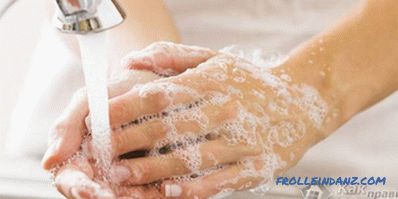 The skin is washed with laundry soap
The skin is washed with laundry soap
If the sealant gets on the skin, then you also need take care of its removal. To clean the silicone residue with hands, you can use a solution of warm water and salt. Hands should be held for a few minutes in a basin (water should completely cover the pollution), and then remove the sealant with a hard washcloth or pumice stone. It is important to note that the silicone may not be removed the first time, so the process must be repeated. Instead of salt, you can use the laundry soap process is completely identical.
If neither salt nor soap help in any way, take vegetable oil, heat it up a little and apply it on the skin. After that, using a washing powder, the skin is rubbed until the sealant is completely removed.
In addition to popular methods, you can also consider special tools that are sold in the store. But to acquire them with a little pollution is irrational.
Remove silicone from tile
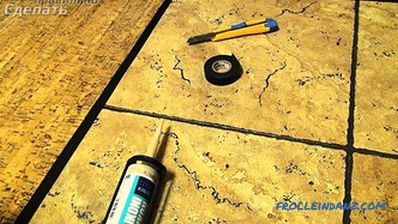
First, cut off any sealant residue from tile as much as possible. This should be done very carefully, so as not to damage the tile. Then rub the cloth in the remains of silicone white spirit / gasoline. This will soften the sealant, it should look like jelly and will be easier to remove.
You can not use tools with abrasive components, because they will scratch the surface of the tile.
Another option is to rub kerosene into the sealant. This combustible mixture also softens it. You can also rub in the remains of silicone detergents. But with their use, the cleaning process is only delayed.
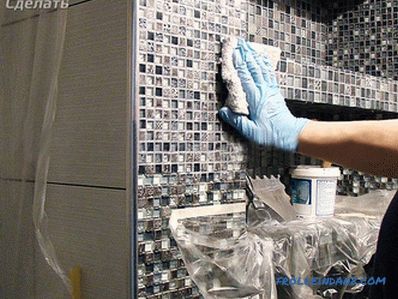 Cleaning the tile
Cleaning the tile
It happens that silicone is not removed by a whole stripe. The reason for this may be an incorrectly chosen cleaning agent, or you may come across a second-grade gasket. In this situation, the process of rubbing one of the above liquids needs to be repeated. Does not help alone? Try another. As a result, the sealant should begin to roll. Remove the formed pellets easiest dry cloth.
What if you need to remove the remains of the seal from a tile that has a porous base? Well, in that case you have to work harder. In this case, the coupling of the tile with silicone is stronger. Apply alternately to the remaining silicone. Remove it can be pumice / scraper.
Before using any solvent, check the reaction of the tile to it in a small area. Otherwise you can spoil the finishing material. This point is especially important to consider when it comes to painted details.
With an acrylic bath
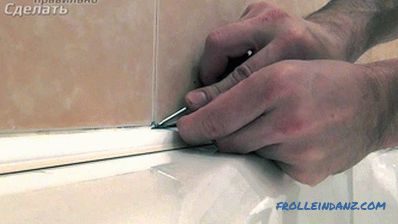
One of the effective tools for removing silicone sealant from an acrylic surface is Dow Corning OS-2. It is sold in the form of a liquid that needs to be applied to the remaining silicone. As a result, it softens and is easily removed. This tool, according to the manufacturer, does not damage the bath surface and is not toxic.Acrylic bath, as tile is afraid of abrasive, because its surface is easily scratched. Therefore, it is important to choose the right sealant remover.
You can also use an already known method - rubbing a sealant with white spirit / detergent. The rest of the method of cleaning sealant is similar to the method of cleaning the tile from the same insulation.
Having considered all the ways to remove silicone sealant, we can make a small conclusion: the cleaning process is quite laborious, so it’s better to prevent the appearance of stains and dirt than to seek a cleaning solution. In the process of sealing the seams, use respirators, rubber gloves and work clothes, and always keep a rag soaked in water at hand.
Video
Removal of sealant using special means:
